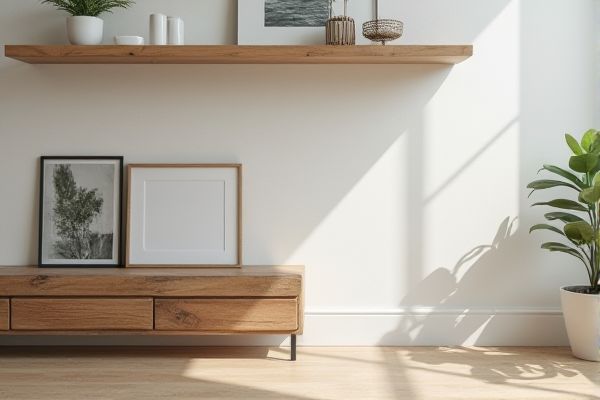
Reclaimed wood shelves offer unique character and durability with natural grain patterns, while floating MDF shelves provide a sleek, modern look with budget-friendly versatility. Discover which option suits your style and needs best by reading the rest of the article.
Table of Comparison
| Feature | Reclaimed Wood Shelf | Floating MDF Shelf |
|---|---|---|
| Material | Recycled hardwood, natural timber | Medium-Density Fiberboard, engineered wood |
| Durability | High durability, resistant to wear | Moderate durability, prone to moisture damage |
| Weight Capacity | Supports heavy loads, ideal for large items | Supports moderate loads, suitable for lightweight items |
| Appearance | Rustic, unique grain patterns, natural finish | Smooth, uniform surface, paintable |
| Environmental Impact | Eco-friendly, reuses wood, reduces waste | Less eco-friendly, manufactured with adhesives and resins |
| Maintenance | Requires occasional sealing or polishing | Low maintenance, easy to clean |
| Cost | Higher cost due to material sourcing | Lower cost, widely available |
| Installation | May require professional installation | Easy DIY installation |
Introduction to Reclaimed Wood and MDF Floating Shelves
Reclaimed wood shelves bring unique character and durability from repurposed timber, offering eco-friendly and rustic charm for your space. Floating MDF shelves provide a sleek, modern look with smooth surfaces and easy customization due to their engineered wood composition. Your choice depends on whether you prefer natural textures and sustainability or minimalist design and affordability.
Aesthetic Appeal: Rustic Charm vs. Modern Minimalism
Reclaimed wood shelves bring a unique rustic charm with natural textures, knots, and weathered finishes that add warmth and character to any space. Floating MDF shelves offer a sleek, modern minimalism with smooth surfaces and clean lines, ideal for contemporary interiors seeking subtle elegance. Your choice depends on whether you prefer the organic, vintage feel of reclaimed wood or the streamlined, understated look of floating MDF.
Material Composition: What Sets Them Apart
Reclaimed wood shelves are crafted from salvaged timber, offering unique grain patterns and natural durability, making each piece distinct and eco-friendly. Floating MDF shelves consist of engineered wood fibers bonded with resin, providing a smooth, uniform surface that is resistant to warping and ideal for modern minimalist designs. The choice between reclaimed wood and MDF hinges on preferences for natural aesthetics versus consistent finish and structural stability.
Durability and Longevity Comparison
Reclaimed wood shelves boast superior durability and longevity due to their dense, aged timber, which often surpasses the lifespan of floating MDF shelves that are prone to warping and damage from moisture over time. The natural resistance of reclaimed wood to wear and its ability to be refinished extends the shelf's functional life, making it a more resilient option for your storage needs. Floating MDF shelves, while affordable and lightweight, generally require more maintenance and may need frequent replacement in high-use or humid environments.
Environmental Impact and Sustainability
Reclaimed wood shelves significantly reduce environmental impact by repurposing existing materials, lowering demand for new lumber and minimizing deforestation. Floating MDF shelves, while cost-effective, often rely on engineered wood products made from resin-bound wood fibers, which may involve formaldehyde emissions and limited recyclability. Choosing a reclaimed wood shelf supports sustainability efforts and helps you reduce your carbon footprint through responsible material reuse.
Installation Process: Ease and Requirements
Reclaimed wood shelves typically require more complex installation due to their heavier weight and the need for robust wall anchors or studs to ensure stability; pre-drilling and careful handling are essential to avoid damage. Floating MDF shelves are lighter and designed for easier installation with integrated mounting brackets or hidden support systems, often requiring only basic tools and minimal wall reinforcement. Both options demand level alignment, but MDF shelves generally offer a quicker, more straightforward setup for DIY enthusiasts.
Customization Options and Design Flexibility
Reclaimed wood shelves offer unparalleled customization options due to their unique textures, grain patterns, and ability to be handcrafted into various shapes and finishes, enhancing rustic and eco-friendly interior designs. Floating MDF shelves provide high design flexibility with smooth, uniform surfaces that can be easily painted or laminated in numerous colors, making them ideal for contemporary, minimalist aesthetics. Both materials support versatile installation styles, but reclaimed wood excels in bespoke, character-rich creations while MDF excels in sleek, modular designs.
Maintenance and Care Differences
Reclaimed wood shelves require regular oiling or sealing to protect against moisture and preserve their natural texture, while floating MDF shelves need less frequent maintenance but are sensitive to water damage and can swell if exposed to moisture. Your reclaimed wood shelf may develop a patina over time, adding character, whereas floating MDF shelves maintain a smooth, uniform finish that may need touch-ups to cover scratches or chips. Proper care for reclaimed wood involves gentle cleaning with a damp cloth, whereas MDF shelves benefit from dusting and avoiding harsh chemicals to prevent surface deterioration.
Cost Analysis: Upfront and Long-Term Expenses
Reclaimed wood shelves often have a higher upfront cost due to sourcing and preparing natural materials, yet their durability and unique aesthetic can increase long-term value by reducing replacement frequency. Floating MDF shelves typically offer a lower initial price and simpler installation but may incur higher maintenance or replacement costs over time because of susceptibility to moisture and wear. Your choice should weigh immediate budget constraints against potential longevity and upkeep expenses to determine the most cost-effective solution.
Best Use Cases: Which Shelf Suits Your Space?
Reclaimed wood shelves excel in rustic or industrial interiors, offering durability and unique character ideal for showcasing heavy items or decorative pieces. Floating MDF shelves suit modern, minimalist spaces where lightweight, cost-effective storage is needed, supporting lighter items with a sleek, seamless look. Choose reclaimed wood for durability and aesthetic depth, while floating MDF is best for budget-friendly, contemporary applications.
 homyna.com
homyna.com